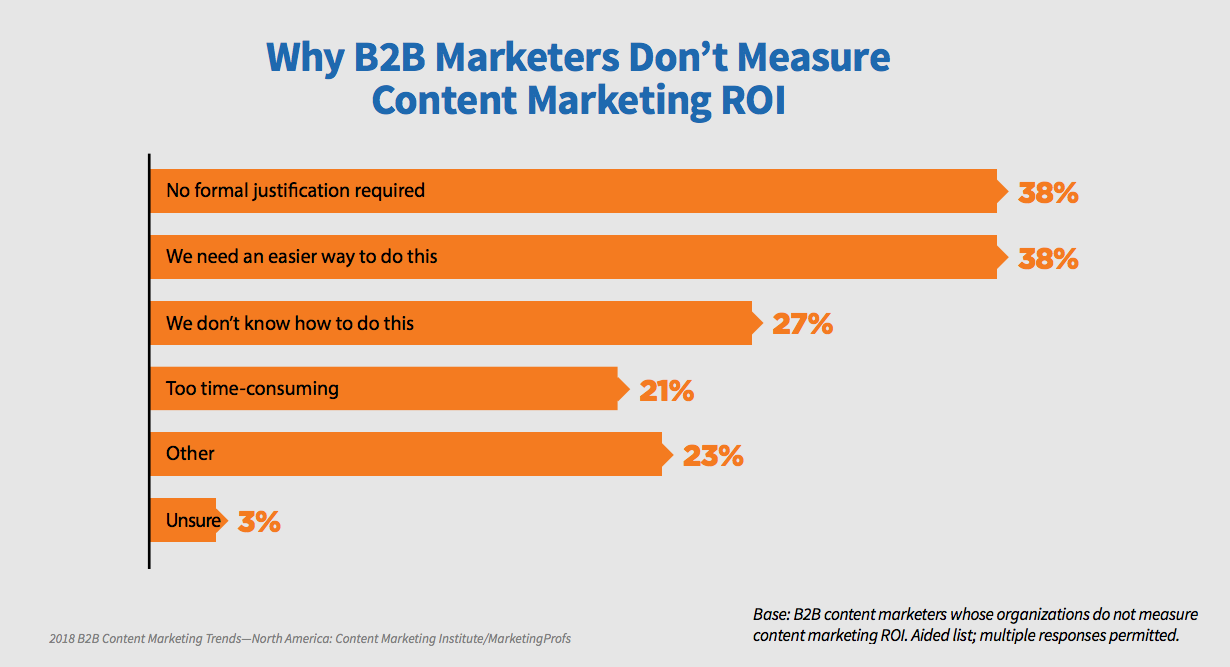How to Boost and Measure ROI of SEO | Golden Spiral

How well are you measuring and reporting on the Return on Investment (ROI) from all of your search efforts?
If you’re struggling, you’re not alone. In 2014, Ensighten (then Animetrix) surveyed chief marketing officers who reported that 63% say “ROI is the standard for their performance” by 2015 but yet, here in 2018, only 44% say “I can measure ROI.”
The Content Marketing Institute reported in their 2018 B2B Benchmarks, Budgets, and Trends Report that most of us are having a hard time.
 Whether you are a part of the 38% looking for an easier path to implementing SEO, the 27% who need more education, the 21% who are having a hard time fitting it into an overstuffed schedule, or you fit into another category, this blog post will help you find a clear path to making SEO work for you.
Whether you are a part of the 38% looking for an easier path to implementing SEO, the 27% who need more education, the 21% who are having a hard time fitting it into an overstuffed schedule, or you fit into another category, this blog post will help you find a clear path to making SEO work for you.
Educating Key Stakeholders
If you’re a CMO or key stakeholder for your company and you’re confused by SEO, keep reading. You’ll gain insight into the process and be able to ask more probing questions of your internal SEO experts or your agency partner. If you are working on SEO inside your company, it’s incumbent upon you to train and educate the rest of your team.
Yes, SEO work and analysis includes difficult math, algorithms, technology, and more. It’s not magic or brain surgery, but it may not be your senior management’s cup of tea. They are smart people. You can bring them onboard. Always remember: at the end of the day, SEO is not about the numbers, it’s about building relationships and supporting those relationships with the data. You can all agree that building relationships is the life blood of what you do.
A basic understanding of SEO leads to clarity and insight. Once you know what you’re tracking, you can see trends. Reports will not offer just numbers, but also insight into your funnel. They will answer questions like:
- Who are these customers?
- Where did they come from?
- Why did they visit our site?
- What questions can we answer for them?
Having these answers will help guide your decision making process.
Defining the Scope of Your SEO
When discovering which keywords to use throughout your search engine marketing (SEM) strategy, you need to uncover the keywords’ value for the potential customer AND your company. When we put a dollar figure next to a keyword for one of our clients, we want everyone to understand why this number is important. Remember, some keywords get lots of search volume but may not convert for your purposes. Others are searched less, but may be more likely to generate one or two new customers that are looking for your exact solution. Depending on the revenue you generate with new business and the revenue generated over the lifespan of a client, one or two digital conversions may justify your digital spend for the month, quarter, or year.
Yes, we all want volume, but volume is relative. It is directly proportionate to your niche. You’re not selling cheeseburgers. You’re selling a customized, highly sophisticated technological solution for a niche market. Find the keywords that make up the volume within your niche bucket, not general keywords that fill the digital ocean.
The proper keyword selection that holds relevancy combined with search terms garnering industry-related volume connects the dots between you and your potential customers.
Tracking Your Efforts
Golden Spiral believes in the power of the key performance indicator (KPI). In short, a goal is your destination paired with a deadline—driving from St. Louis to Memphis by 2 p.m., Tuesday. It’s a binary matter; did you get there or not? A KPI answers, “how do you know you’re making the right amount of progress?” One KPI for this journey may be tracking average miles per hour. If you leave at 9 a.m., your KPI would be 56.8 MPH (or 64 to give yourself room for a bathroom break).
What are your marketing goals for this quarter? Have you determined your KPIs for each one? If not, take some time to create the measuring stick for your KPIs. A starting place for KPI writing will be your month-over-month or year-over-year statistics.
Once you have team buy-in on the KPI language, create a custom dashboard to report on each one at a frequency your team needs. We recommend weekly.

Remember, different KPIs require different SEO strategies and will be measured by different metrics. For example, if you are building brand awareness, your KPIs and efforts will focus on impressions, social listening, and social awareness as well as inbound links from multiple resources. If you are concerned primarily with gaining a certain number of new customers in the next six months, the KPI, the SEO work, and the measurements will be radically different. You’ll be tracking click-throughs from email and display ads, form conversions, and travel through the buyer’s journey.
Attributing the Results
Attribution can be a sticking place for many companies. Who does the lead belong to? Who gets credit for the ultimate sale?
There are many methods and philosophies about attribution. We believe in the power of team. Everyone is responsible for nurturing and converting each lead. The more touches you have with a potential client, the better chance you have of converting that client. Don’t work against yourself between marketing and sales. The ultimate goal is new business. As the old adage made famous by John F. Kennedy says, “A rising tide lifts all boats.” In our opinion, the simplest and least contentious plan is an even distribution of credit called linear attribution. For every touch, you give some amount of attribution.
For example, if in your sales funnel, you know you get a conversion after ten touches. You might look back and determine that five of those touches were from search, three were from social, and two were from direct traffic. If the last touch resulted in a form conversion, the web team wasn’t the only one who made that happen. That conversion is the result of an integrated team effort. Your analytics and reporting will allow you to attribute a certain percentage of credit to each team based on the statistics.
Making ROI of SEO Easier to Measure
Like most things in life, SEO measurement is easiest with a solid foundation. In this case, goals and corresponding KPIs are your bedrock. There are many free and paid mechanisms to help you track and report SEO. Google Search Console and Google Analytics are free. Other sources like Raven and SEMrush have paid components.
I like to start measuring dollars spent with paid search. You can concretely track what you’re doing from a paid standpoint. Simply put, you are spending money to create digital assets. Users click on those assets. Users travel through the funnel. Users become customers. It’s straightforward. Using Google’s tools, you can determine how much it costs for every click for a certain keyword.
For every X dollars you spend, you receive Y visits/calls/completed forms. It costs Z per Marketing Qualified Lead (MQL).
Our example company, Cyclometricology invests $2,000 per month in paid efforts
- They employ 20 keywords
- Those keywords receive a total of 10,000 combined impressions.
- Those keywords’ ads receive a total of 400 clicks per month.
- The investment in each keyword equals $100 dollars per month.
Based on this example:
- The cost per thousand (CPM) impressions is $200.
- The cost per click (CPC) is $5.00.
- The click-through rate (CTR) is 4%.
Baselines vary in the B2B space, but we’ve seen CPCs average between $6 and $15. A 4% CTR is the average across several industries*.
This example focuses specifically on actual click throughs. Most of the time, businesses combine a click campaign with an exposure or brand awareness campaign. They want to increase the number of users who know who they are and what they do.
SEO Reporting Best Practices
With our clients, we take an iceberg approach to reporting. We prepare a slide deck or PDF report with many pages. On the top page, we use clear and concise examples. Here we list the top five performing keywords and their conversions from each avenue: organic and paid. I outline how much we spent per keyword and the number of attributable conversions per keyword. We close this page with:
The Paid ROI is $X per $Y spent.
If our internal leadership or our client’s key stakeholders want to ask deeper questions, we’re ready. We can go below the waterline to the rest of the iceberg. We have all the supporting reports they could want.
Key Takeaway
Determining ROI of SEO is essential to your future growth. It’s not simple, but you can make it easier. SEO is built on human nature, technology, and iron-clad marketing principles. Navigating those matters takes times.
The mission of an SEO expert—whether in your company or at the agency you’ve hired—is to take the mystery out of what’s behind the digital curtain and translate data quickly into meaningful insights to inform the overall strategy.
*Based on data for our clients in B2B industries including healthcare IT, cybersecurity, web data harvesting, and data management solutions.


